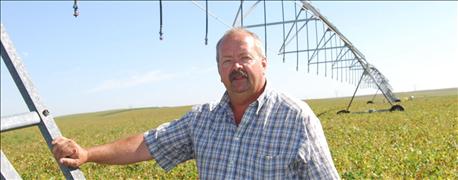
The Daugherty Water for Food Institute in Lincoln kicked off in April with a premiere of Conrad Weaver's latest documentary, Thirsty Land. The film, from the same studio and director who brought us Great American Wheat Harvest, highlights a challenge that's been all too real for western agriculture in recent years: drought and the challenges that come with a lack of water.

AG IS ADAPTING: Thirsty Land gives a firsthand perspective of how growers and urban residents are adapting and getting more efficient in their water use – including growers like Roric Paulman, who uses telemetry, variable-rate, and remote sensing and monitoring technologies to irrigate more efficiently on his farm near Sutherland in western Nebraska.
The Robert B. Daugherty Water For Food Institute along with the Institute of Agriculture and Natural Resources, both at the University of Nebraska-Lincoln partnered with Weaver to produce the film, which addresses how a lack of water impacts growers and urban residents west of the 100th meridian in states like California, Washington, Nevada, Colorado, Nebraska and Kansas.
"When I was filming Great American Wheat Harvest, the number one issue I heard when working with farmers was water," says Weaver, producer and director at Conjo Studios. "Water kept coming to the surface, and that was the catalyst that drew me to the subject."
But Thirsty Land isn't just about how drought impacts farmers and municipalities in the west. It's also about how they are adapting to change. "What I heard over and over again was 'we have to adapt.' Farmers learn to adapt to the weather and conditions they're given," Weaver says. "It's pretty amazing to see what farmers go through to be able to produce a crop in order to make a living and sustain their business."
This might mean adapting by changing management practices and growing less water-intensive crops, using precision technology like telemetry and remote sensing to irrigate more efficiently, or leaving acres fallow – the film points out that 550,000 acres of California farmland were left fallow in 2015.
Thirsty Land gives a firsthand perspective of how growers and urban residents are adapting to these changes – including growers like Roric Paulman, who uses telemetry, variable-rate, and remote sensing and monitoring technologies to irrigate more efficiently on his farm near Sutherland in western Nebraska.
For example, during the 2012 drought, Paulman and other irrigators in the Middle Republican Natural Resources District were capped on how much water they could use to irrigate their crops. Paulman, who had been using in-field weather stations to match crop water use with daily evapotranspiration, decided to plant drought-tolerant corn on a 90-degree section of a pivot equipped with variable speed control, and adjust the amount of water applied per section accordingly.
Paulman was able to reduce his water use to about 60% of the crop irrigation requirement (CIR) on that 90-degree section. While this pivot yielded 208 bushels per acre – 42 bushels less than his farm across the road in the Twin Platte NRD – Paulman was still able to profit while using less water, he says. "That's a real-world instance in adapting to the challenges Mother Nature puts in front of you," Paulman says. "Being adaptable is really going to play into agriculture looking at the challenges we're facing going forward."
Bringing a personal touch to the film with these kinds of perspectives helps show a wider audience how water affects everyone – from the farmer to the everyday consumer and residential water-user.
"These are real people that have lives, and their lives are interrupted in many ways by a lack of water. When you see that footage back east, people are just floored," Weaver says. "They didn't realize it goes on here in the U.S. In the east, we often deal with too much water. When you put flesh and bone to a story like that it really better helps people understand. And when you bring a farmer dealing with these issues too, it helps understand that these people growing food for us have some pretty big challenges ahead of them."
About the Author(s)
You May Also Like






